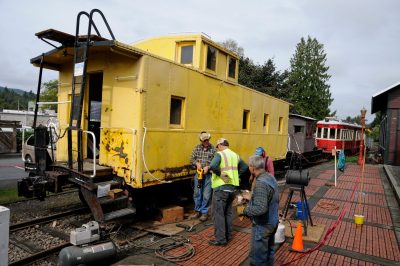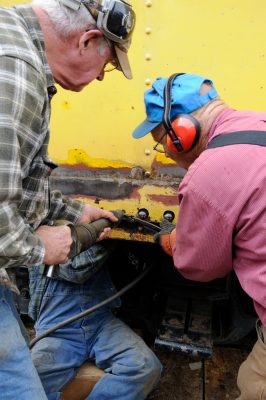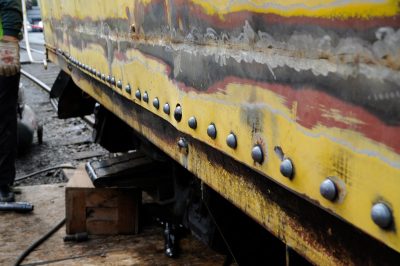 Traditional methods and materials are essential to good collections care at a railway museum. So over the last nine months, Volunteers and full time staff at the Northwest Railway Museum have been learning to hot rivet. Hot riveting was (is) used to attach two or more metal parts and was widely used in car and locomotive construction prior to the widespread introduction of electric welding. It is labor intensive and is almost a lost art.
Traditional methods and materials are essential to good collections care at a railway museum. So over the last nine months, Volunteers and full time staff at the Northwest Railway Museum have been learning to hot rivet. Hot riveting was (is) used to attach two or more metal parts and was widely used in car and locomotive construction prior to the widespread introduction of electric welding. It is labor intensive and is almost a lost art.
 The riveting crew recently had an opportunity to try out their skills. The Museum has contracted to perform some rehabilitation work on Issaquah Historical Society’s former Weyerhaeuser caboose. A damaged section of side sheet needed to be reattached to the side sill. So approximately 36 replacement rivets were required.
The riveting crew recently had an opportunity to try out their skills. The Museum has contracted to perform some rehabilitation work on Issaquah Historical Society’s former Weyerhaeuser caboose. A damaged section of side sheet needed to be reattached to the side sill. So approximately 36 replacement rivets were required.
A gas-fired forge was moved from the Conservation and Restoration Center to the Issaquah Depot. An air compressor, a rivet gun, and some hand tools also made the trip. And on a cool September morning, all the tools were set up to begin riveting.
 When the rivets were orange, Roger S. picked up a rivet with the tongs and inserted it into a hole in the caboose side. Clark M. alternating with Bill W. “bucked” the rivet with a second unpowered rivet gun while Allan W. operated the powered rivet gun. The die in Allan’s gun shaped the now red hot end of the rivet into an oval head to secure it on the inside of the caboose frame. As the rivet cooled, it shrank and pulled the side sheet very tightly against the side sill.
When the rivets were orange, Roger S. picked up a rivet with the tongs and inserted it into a hole in the caboose side. Clark M. alternating with Bill W. “bucked” the rivet with a second unpowered rivet gun while Allan W. operated the powered rivet gun. The die in Allan’s gun shaped the now red hot end of the rivet into an oval head to secure it on the inside of the caboose frame. As the rivet cooled, it shrank and pulled the side sheet very tightly against the side sill.

